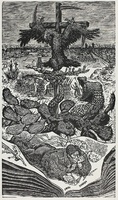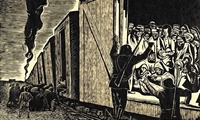 What May Come (Mexico, 1945)
What May Come (Mexico, 1945) A signal image in Méndez’s oeuvre, this work is one of only three self-portrait prints made by the artist. Also known as Danger over Mexico and That Which Must Not Come, the print reflects upon the role of the politically engaged artist in Mexico at the end of World War II, a period of great uncertainty. In the print, the figure of Méndez lies across an open sketchbook and contemplates a nightmarish vision in which Mexican national symbols—the eagle, snake, and nopal cactus (references to the legend of the founding of Tenochtitlan, ancient Mexico City)—are grotesquely inverted, and social order is threatened by reactionary forces. The eagle, symbol of the Mexican republic, hangs on a swastika-cross, and behind, a column of fascist soldiers, supported by Catholic clerics, marches on Mexico City.
The museum’s Print and Drawing Club commissioned Méndez to make the woodblock for this print.
 Deportation to Death (Death Train)
Deportation to Death (Death Train) With more than two dozen illustrations by 11 artists of the Taller de Gráfica Popular, The Black Book of Nazi Terror in Europe (1943) was the group’s most important antifascist collaboration with the European exile community in Mexico. Supported by the government of Manuel Ávila Camacho, this groundbreaking book extensively documented Nazi atrocities through testimonies, statistics, photographs, and illustrations, with contributions by well-known European, American, and Latin American writers and artists. Many of the Taller’s illustrations were also produced as individual prints, including the three displayed here. Méndez’s Deportation to Death is perhaps the earliest print related to the Holocaust and the death camps. Méndez’s print focuses on the deportation of Jews from Europe’s ghettos, their humble clothing and pained countenances revealed in expressionistic fashion by the Nazi soldier’s lamp.
 What May Come (Mexico, 1945) A signal image in Méndez’s oeuvre, this work is one of only three self-portrait prints made by the artist. Also known as Danger over Mexico and That Which Must Not Come, the print reflects upon the role of the politically engaged artist in Mexico at the end of World War II, a period of great uncertainty. In the print, the figure of Méndez lies across an open sketchbook and contemplates a nightmarish vision in which Mexican national symbols—the eagle, snake, and nopal cactus (references to the legend of the founding of Tenochtitlan, ancient Mexico City)—are grotesquely inverted, and social order is threatened by reactionary forces. The eagle, symbol of the Mexican republic, hangs on a swastika-cross, and behind, a column of fascist soldiers, supported by Catholic clerics, marches on Mexico City. The museum’s Print and Drawing Club commissioned Méndez to make the woodblock for this print.
What May Come (Mexico, 1945) A signal image in Méndez’s oeuvre, this work is one of only three self-portrait prints made by the artist. Also known as Danger over Mexico and That Which Must Not Come, the print reflects upon the role of the politically engaged artist in Mexico at the end of World War II, a period of great uncertainty. In the print, the figure of Méndez lies across an open sketchbook and contemplates a nightmarish vision in which Mexican national symbols—the eagle, snake, and nopal cactus (references to the legend of the founding of Tenochtitlan, ancient Mexico City)—are grotesquely inverted, and social order is threatened by reactionary forces. The eagle, symbol of the Mexican republic, hangs on a swastika-cross, and behind, a column of fascist soldiers, supported by Catholic clerics, marches on Mexico City. The museum’s Print and Drawing Club commissioned Méndez to make the woodblock for this print. Deportation to Death (Death Train) With more than two dozen illustrations by 11 artists of the Taller de Gráfica Popular, The Black Book of Nazi Terror in Europe (1943) was the group’s most important antifascist collaboration with the European exile community in Mexico. Supported by the government of Manuel Ávila Camacho, this groundbreaking book extensively documented Nazi atrocities through testimonies, statistics, photographs, and illustrations, with contributions by well-known European, American, and Latin American writers and artists. Many of the Taller’s illustrations were also produced as individual prints, including the three displayed here. Méndez’s Deportation to Death is perhaps the earliest print related to the Holocaust and the death camps. Méndez’s print focuses on the deportation of Jews from Europe’s ghettos, their humble clothing and pained countenances revealed in expressionistic fashion by the Nazi soldier’s lamp.
Deportation to Death (Death Train) With more than two dozen illustrations by 11 artists of the Taller de Gráfica Popular, The Black Book of Nazi Terror in Europe (1943) was the group’s most important antifascist collaboration with the European exile community in Mexico. Supported by the government of Manuel Ávila Camacho, this groundbreaking book extensively documented Nazi atrocities through testimonies, statistics, photographs, and illustrations, with contributions by well-known European, American, and Latin American writers and artists. Many of the Taller’s illustrations were also produced as individual prints, including the three displayed here. Méndez’s Deportation to Death is perhaps the earliest print related to the Holocaust and the death camps. Méndez’s print focuses on the deportation of Jews from Europe’s ghettos, their humble clothing and pained countenances revealed in expressionistic fashion by the Nazi soldier’s lamp.